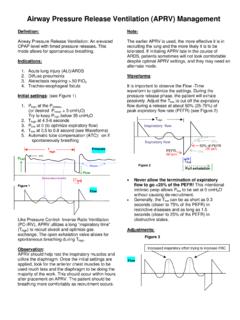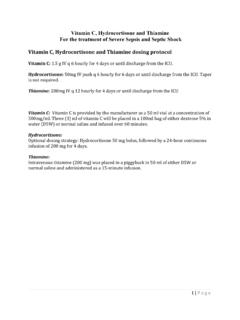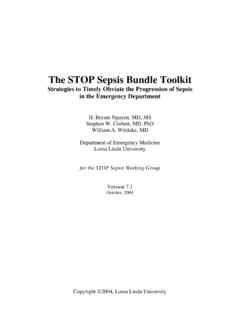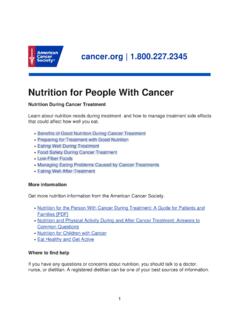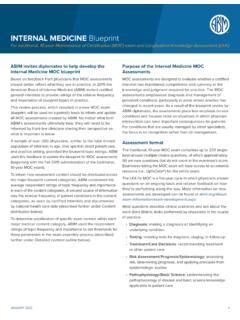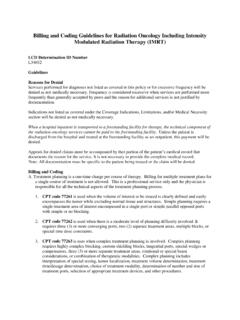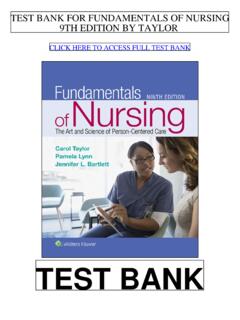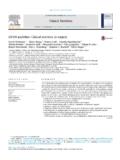Transcription of Nutrition in Clinical Practice http://ncp.sagepub.com ...
1 In Clinical Practice online version of this article can be found at: DOI: 2000 15: 94 Nutr Clin PractGerald L. SchmidtTechniques and Procedures: Guidelines for Managing Electrolytes in Total Parenteral Nutrition Solutions Published by: behalf of: The American Society for Parenteral & Enteral Nutrition can be found at: Nutrition in Clinical PracticeAdditional services and information for Alerts: : : : What is This? - Apr 1, 2000 Version of Record >> at NEW YORK UNIV on September 10, from Techniques and Procedures Guidelines for Managing Electrolytes in Total Parentera1 Nutrition Solutions Gerald L. Schmidt, PharmD, BCNSP Department of Pliarinacy Practice , University of Florida, Jaclzsoii ville; and Department of Pliari~zacy, Shands Jaclzsoiiville, Florida ABSTRACT: To many practitioners, managing electro- lytes in total parenteral Nutrition (TPN) solutions has been considered an art rather than a science.
2 Electrolytes are typically taught by gut feeling rather than by a structured approach. Consequently, most practitioners manage electrolytes differently, with varying degrees of success. Inconsistent prescribing often results in over- or undercorrection, with consequential adverse events and/or increased workload. These inconsistencies led my organi- zation to develop dosing guidelines for the management of electrolytes in parenteral Nutrition solutions. The guide- lines are based on the literature and our Clinical experi- ence. They are designed specifically to teach a standard- ized process for making electrolyte adjustments. They were also designed to give a better idea of the amounts of electrolytes needed and the expected corresponding change in serum levels.
3 Since implementing the guide- lines, we have noticed an improvement in electrolyte management. Managing electrolytes in parenteral Nutrition (PN) solutions is often considered an art rather than a science. Electrolytes are typically taught by gut feeling rather than by a structured approach to managing fluids and electrolytes. Consequently, most practitioners manage electrolytes differently, with varying degrees of success. In my organization, we found this to be a common problem that was associated with new residents entering our training program. Residents either made minute changes with little or no impact in serum levels, or dramatic changes that resulted in overcorrection. This in turn led to another change in the fluid, and a mainte- Correspondence and reprint requests: Gerald L.
4 Schmidt, PharmD, BCNSP, Department of Pharmacy, Shands Jackson- ville, 655 West 8th Street, Jacksonville, FL 32209. Electronic mail may be sent to 0884-5336/00/1602-0091$ Nutrition in Clinical Practice 15:94-109, April 2000 Copyright 0 2000 American Society for Parenteral and Enteral Nutrition nance amount was never established. These incon- sistencies led us to develop dosing guidelines for the management of electrolytes in PN solutions. The goals of the Electrolyte Dosing Algorithms were as follows: (1) create a standardized process for adjusting electrolytes, (2) decrease time to correct electrolyte abnormalities, (3) decrease number of electrolyte changes in PN orders, and (4) create an easy-to-use teaching tool that would better predict electrolyte requirements and corresponding serum levels.
5 The Nutrition Subcommittee developed the algo- rithms on the basis of literature and Clinical experi- ence, and conditional approval by the P & T Com- mittee was granted in 1992, The algorithms were used throughout the hospital on all types of patients, including patients with renal dysfunction and multi- organ system failure. One hundred and forty-four patients were evaluated, representing 696 patient days of PN therapy. Three hundred and seventy-six (54%) patient days were managed exclusively by our standard electrolyte composition. The remaining 320 (46%) patient days required adjustment of elec- trolytes. The most common reasons for adjusting electrolytes were hypokalemia, hypomagnesemia, and hypophosphatemia in trauma and refeeding, and hyperkalemia and hyperphosphatemia in renal dysfunction.
6 There were 44 (38%) instances where the electrolyte algorithms were used and 72 (62%) incidents where traditional empiric dosing was used. In all 44 situations using the algorithms, serum electrolyte levels returned to normal within 48 hours. There were no adjustments resulting in overcorrection. The average time to correction of electrolyte abnormalities was 2 days. Of the 72 situations treated outside of the algorithms, 56 ( ) corrected in 1 to 6 days and 7 ( ) overcorrected. It took an average of 2 days to correct the serum abnormalities (see Table 1). The algorithms were felt to be a significant improvement from previous therapy; therefore, the Nutrition Sub- committee recommended the adoption of the algo- rithms to the P & T Committee.
7 The P & T Com- mittee granted final approval in 1992, and the algorithms were published in the Nutritional Sup- port Services Handbook. The algorithms are not 94 at NEW YORK UNIV on September 10, from April 2000 ELECTROLYTE RIANAGERIENT IN TI" 95 Table 1 Comparison OF protocol vs nonprotocol When using the protocols, there arc several points to remember: Protocol Nonprotocol Number of abnormal values 44 72 Corrected 44 (100%) 56 ( ) Days to correct 2 -c Overcorrected 0 (0%) 7 ( ) mandatory, but all recommendations from the Nutritional Support Services follow the guidelines. The algorithm for acute replacement of phosphate started out as a resident project. Before the study, the standard phosphate dose for hypophosphatemia was either 15 mmoVL or 30 mmoVL.
8 In most cases with serum levels < mg/dL, this was not enough to raise the serum phosphate level to an acceptable level. The goal was to give a supplemental dose of phosphate that would increase serum levels to at least 2 mg/dL without causing hyperphosphatemia (serum level > mg/dL). Initial concerns included metastatic calcifications and overcorrection of serum phosphate levels. Three adjustments were made in an attempt to alleviate these problems. The infusion rate was limited to mmol/Wh to give the phos- phate time to enter the cell and to avoid depression of serum calcium levels and metastatic calcifica- tions; the dose was empirically decreased by 50% in patients with renal disease; and an adjusted body weight was used in obese patients.
9 Initial guidelines recommended were as follows: mmol/Wkg for serum level from to 2 mg/dL; mmoVL/kg for levels from 1 to mg/dL; and mmol/l/kg for serum levels <1 mg/dL. After a pilot study, these guidelines were found subtherapeutic. The guide- lines were then readjusted to their current levels (see Appendix K). Of particular interest was the fact that doses did not have to be adjusted for patients with renal dysfunction. The protocol is for acute replacement, and renal failure is not an issue unless there is a maintenance infusion, which may allow phosphate to accumulate. Hundreds of patients have been treated using the phosphate protocol. The supplementation guidelines increase the serum phosphate to greater than 2 mg/dL in 85% to 90% of the patients treated.
10 There was only 1 patient with resultant phosphate levels higher than mg/dL. This patient had renal disease and was receiving maintenance phosphate. The level was taken 72 hours after the supplemental dose was given. The resultant level of mg/dL was probably due to the maintenance fluid and not the supplemental phos- phate. Unfortunately, a controlled study comparing these algorithms with other therapy has not been done. However, since implementation of the algo- rithms, a reduction in the number of changes needed in PN orders and the number of electrolyte abnor- malities commonly seen with PN therapy have been observed. 1. 2. 3. 4. 5. Acute electrolyte problems are best corrected with a supplemental infusion; do not correct them with a maintenance solution such as PN.
